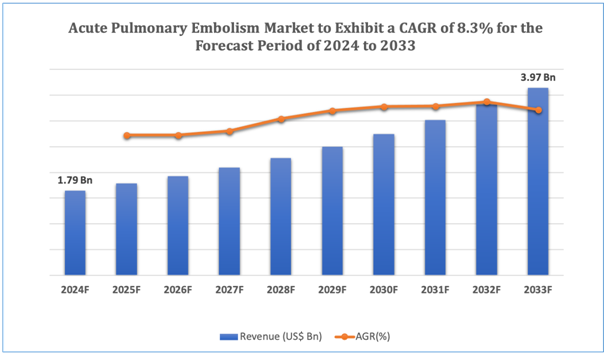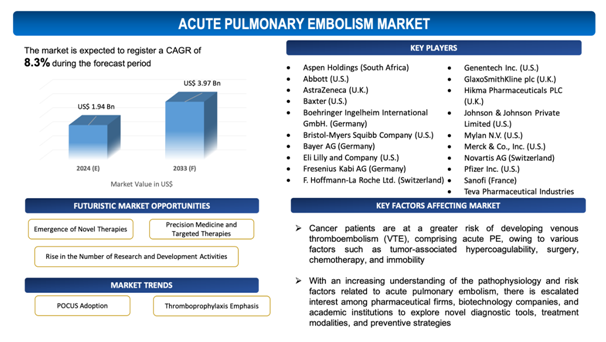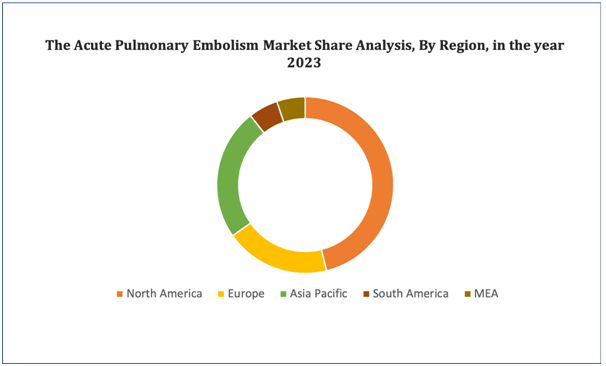Acute Pulmonary Embolism Market Overview
The global Acute Pulmonary Embolism market is estimated to be worth over USD 3.97Bn in 2033 and is expected to grow at CAGR of 8.3% during the forecast period (2024-2033).
Acute pulmonary embolism (PE) represents a crucial medical emergency marked by the abrupt blockage of one or more arteries in the lungs, generally caused by blood clots displaced from deep veins, most frequently in the legs. This obstruction hinders blood flow to the lungs, resultingin potentially life-threatening consequences such as shortness of breath, chest pain, swift heart rate, and in severe cases, cardiogenic shock or sudden death. Acute PE is a substantial global health concern, contributing to increased morbidity and mortality rates. Risk factors for PE comprise recent surgery, immobility, cancer, smoking, obesity, and a history of thromboembolic events.
The global market for acute pulmonary embolism surrounds a thoroughscale of diagnostic, treatment, and preventive measures focused at minimizing the incidence, severity, and complexities associated with this condition. Diagnostic tools comprise imaging techniques such as ventilation-perfusion (V/Q) scans, computed tomography pulmonary angiography (CTPA), and blood tests to determine biomarkers indicative of thrombotic events. Early and accurate diagnosis is critical for initiating prompt treatment and preventing adverse outcomes.
Treatment alternatives for acute PE vary depending on the severity of the condition and the patient's risk profile. Anticoagulant medications, such as heparin and direct oral anticoagulants (DOACs), are commonly used to avoid further clot formation and support thrombus resolution. Thrombolytic therapy are likely to be considered in high-risk patients with massive or submassive PE to swiftly dissolve blood clots and restore pulmonary blood flow. Surgical interventions, such as embolectomy or catheter-directed thrombolysis, are reserved for cases refractory to medical therapy or in hemodynamically unstable patients requiring urgent intervention.
Preventive measures hold a critical role in mitigating the risk of venous thromboembolism, comprising pharmacological thromboprophylaxis with anticoagulant medications, mechanical compression devices, and early ambulation protocols for hospitalized patients at escalated risk. With the soaring recognition of acute pulmonary embolism as a major public health concern, there is growing focus on raising awareness, enhancing risk stratification, and implementing evidence-based management strategies to optimize patient outcomes and reduce the global burden of this potentially fatal condition.
Figure 1. Acute Pulmonary Embolism: Market Size

Get more details on this report - Request Free Sample
Key Market Insights &Current Market Landscape:
The global acute pulmonary embolism (PE) market is marked by significant developments and novel technologies focused at enhancing diagnosis, treatment, and management of this life-threatening condition. Diagnostic imaging modalities such as computed tomography pulmonary angiography (CTPA) and ventilation-perfusion (V/Q) scans continue to hold a crucial role in precisely detecting pulmonary emboli. However, innovations in imaging techniques, comprising dual-energy CT and perfusion MRI, providesimproved visualization and characterization of emboli, contributing to more accurate diagnosis and risk stratification. In addition to that, novel technologies such as point-of-care ultrasound (POCUS) enable rapid bedside assessment of patients with suspected PE, supporting timely intervention and mitigating time to diagnosis. In terms of treatment, anticoagulant medications remain the foundation, with direct oral anticoagulants (DOACs) gaining prominenceowing to their efficiency and convenience in compared to conventional therapies. Thrombolytic therapy and surgical interventions are reserved for high-risk patients or those with massive or submassive PE. As the panorama of acute PE management evolves with advancements in technology and treatment modalities, there are opportunities for further innovation to address unmet needs and enhance outcomes for patients across the world.
Market Dynamics
Market Drivers
Increasing Prevalence of Cancer
Cancer patients are at a greater risk of developing venous thromboembolism (VTE), comprising acute PE, owing to various factors such as tumor-associated hypercoagulability, surgery, chemotherapy, and immobility. With cancer incidence on the surgeacross the globe, specifically in geriatric populations, the number of individuals at risk of experiencing acute PE is also increasing. Cancer killed about 10 million people in 2020, according to the World Health Organization. In addition to that, advancements in cancer treatments have paved its way to enhanced survival rates, leading to a soaring population of cancer survivors who are likely to still face long-term complexities such as VTE. This elevated awareness of VTE risk among cancer patients and healthcare providers highlights the prominence of early detection, prevention, and management strategies for acute PE. As a consequence, the expanding prevalence of cancer contributes to the demand for diagnostic tools, treatment alternatives, and preventive measures in the global acute PE market, fueling growth and innovation to address the particular needs of this patient population.
Market Restraints
With regard to numerous advantages of Acute Pulmonary Embolism, the market faces several challenges due to the unique characteristics and requirements associated with them. Some of the key market challenges include:
- Limited Awareness and Knowledge: Limited awareness and knowledge among healthcare professionals and the general population serve as substantial market restraints for the global acute pulmonary embolism (PE) market. Several cases of acute pulmonary embolism go undiagnosed or misdiagnosed attributing to an inadequacy of recognition of symptoms and risk factors. Along with that, there are likely to be delays in seeking medical attention or implementing appropriate treatment protocols. Enhanced education and awareness campaigns are necessitating to improve early detection and management of acute PE, ultimately mitigating morbidity and mortality associated with this life-threatening condition.
Market Opportunities
Rise in the Number of Research and Development Activities
With an increasing understanding of the pathophysiology and risk factors related to acute pulmonary embolism, there is escalated interest among pharmaceutical firms, biotechnology companies, and academic institutions to explore novel diagnostic tools, treatment modalities, and preventive strategies. R&D efforts emphasize on developing advanced imaging techniques for more precise and timely diagnosis, as well as recognizing biomarkers for risk stratification and prognosis assessment. Moreover, there is ongoing exploration of innovative therapeutic interventions, comprising novel anticoagulant medications, targeted therapies, and minimally invasive procedures for acute PE management. Collaborative research initiatives and clinical trials hold a critical role in assessing the safety and efficiency of these emerging interventions, leading the way for their consolidation into clinical practice. The expansion of R&D activities not only nurtures innovation and technological advancements but also improves the overall panorama of acute PE management, providing new opportunities to enhance patient outcomes, mitigate morbidity and mortality, and address the unmet medical needs of individuals affected by this life-threatening condition.
Market Trends
- POCUS Adoption: The global acute pulmonary embolism (PE) market experience a soaring trend in the adoption of point-of-care ultrasound (POCUS). POCUS allowsswift bedside assessment, helping in the timely diagnosis and management of acute PE, particularly in high-risk patients. This trend indicates efforts to improve diagnostic capabilities and streamline patient care processes, contributing to enhanced outcomes and mitigated time to treatment initiation.
- Thromboprophylaxis Emphasis: There is a soaring focus on thromboprophylaxis strategies in the global acute PE market, emphasized at avoiding venous thromboembolism (VTE) in hospitalized patients. Pharmacological and mechanical interventions are increasingly utilized to minimize the risk of acute PE and associated complications, streamlining with efforts to enhance patient safety and mitigate healthcare costs. This trend highlights the prominence of preventive measures in high-risk populations, focusing on the need for comprehensive thromboprophylaxis protocols in clinical practice.

Get more details on this report - Request Free Sample
Acute Pulmonary Embolism Market: Key Segments
By Symptoms
- Shortness of Breath
- Chest Pain
- Cough
- Irregular Heartbeat
- Dizziness
- Fever
- Cyanosis
- Others
By Diagnosis
- Chest X-Ray
- ECG
- MRI
- CT Scan
- Pulmonary Angiography
- Venography
- Venous Ultrasound
- D-Dimer Test
- Others
By Treatment
- Medications
- Mechanical Devices
- Surgery
- Others
By End-Users
- Hospitals
- Specialty Clinics
- Homecare
- Others
By Distribution Channel
- Hospital Pharmacy
- Retail Pharmacy
- Online Pharmacy
- Others
By Key Geographical Regions
- North America
- Europe
- Asia-Pacific
- Middle East and Africa
- South America
Acute Pulmonary Embolism Market: Regional Analysis
North America dominates the global pulmonary embolism market because of the presence of major key players and growing prevalence of pulmonary embolism diseases in this region. Asia-Pacific is expected to grow during the forecast period due to rising number of geriatric people and increasing prevalence of pulmonary embolism in this region.
Figure 4. Acute Pulmonary Embolism Market: Distribution by Region

Get more details on this report - Request Free Sample
Leading Acute Pulmonary Embolism Developers
Industry Trends and Global Forecasts, 2023-2035 report features an extensive study of the current market landscape, market size and future opportunities associated with the Acute Pulmonary Embolismmarket, during the given forecast period. Further, the market report highlights the efforts of several stakeholders engaged in this rapidly emerging segment of the biopharmaceutical industry. Key takeaways of the Acute Pulmonary Embolismmarket are briefly discussed below.
The report includes the list of players operating in the global Acute Pulmonary Embolismmarket. Some of the key players include:
- Aspen Holdings (South Africa)
- Abbott (U.S.)
- AstraZeneca (U.K.)
- Baxter (U.S.)
- Boehringer Ingelheim International GmbH. (Germany)
- Bristol-Myers Squibb Company (U.S.)
- Bayer AG (Germany)
- Eli Lilly and Company (U.S.)
- Fresenius Kabi AG (Germany)
- F. Hoffmann-La Roche Ltd. (Switzerland)
- Genentech Inc. (U.S.)
- GlaxoSmithKline plc (U.K.)
- Hikma Pharmaceuticals PLC (U.K.)
- Johnson & Johnson Private Limited (U.S.)
- Mylan N.V. (U.S.)
- Merck & Co., Inc. (U.S.)
- Novartis AG (Switzerland)
- Pfizer Inc. (U.S.)
- Sanofi (France)
- Teva Pharmaceutical Industries Ltd.(Jerusalem)
Recent Developments in the Acute Pulmonary Embolism Market
Several recent developments have taken place in the field of Acute Pulmonary Embolism, some of which have been outlined below. These developments, even if they took place post the release of our market report, substantiate the overall market trends that we’ve outlined in our analysis chronologically.
- In April 2022, AngioDynamics, Inc., a leading and transformative medical technology company focused on restoring healthy blood flow in the body’s vascular system, expanding cancer treatment options and improving quality of life for patients, announced the launch of the Acute Pulmonary Embolism Extraction Trial with the AlphaVac System (APEX-AV), a new clinical study aimed at evaluating the efficacy and safety of their AlphaVac Multipurpose Mechanical Aspiration (MMA) F1885 System in the treatment of acute intermediate-risk pulmonary embolism (PE).
Scope of the Report
The market report presents an in-depth analysis of the various firms / organizations that are engaged in this market, across different segments, as defined in the below table:
|
Key Report Attributes |
Details |
|
Base Year |
2023 |
|
Forecast Period |
2024-2033 |
|
CAGR (2024-2033) |
8.3% |
|
Symptoms |
|
|
Diagnosis |
|
|
Treatment |
|
|
End User |
|
|
Distribution Channel |
|
|
Key Geographical Regions |
|
|
Key Companies Profiled |
|
